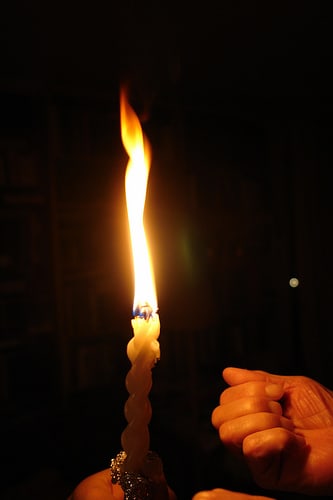One way we honor and indulge the Shabbat is by eating three meals on Shabbat itself. But we also honor the Sabbath by accompanying it as it departs with an additional meal, the “melave malka”, “accompanying the queen”, on Saturday night (SA OC 300, based on Shabbat 119b).
The Bet Yosef relates a remarkable tradition brought down in the book Shibulei HaLeket: that the melave malka meal is specially important because it alone nourishes a special bone known as the NISKOI, from which the body is reconstructed at the time of the resurrection. Later commentaries explain that this is the same as the LUZ, which is mentioned in many Midrashim as a bone in the base of the spine which is completely indestructible. Even if the body is ground or burnt, the LUZ remains intact; thus, there is always one part of the body which remains intact from which to reconstruct the whole at the time of the resurrection.
First, let us explain the significance of this Midrash; then we will explain its connection to the Melave Malka.
A recurring theme in Jewish tradition is that the ultimate goal of creation, and the specific purpose of the commandments of the Torah, is to create a perfect fusion of matter and spirit. Judaism doesn’t seek the perfection of the body alone, nor of the soul alone; it doesn’t even pursue their separate perfection. Rather, the object is always to infuse matter with spirit. This explains our rather ambivalent relationship to material enjoyments: to the extent that these enjoyments emphasize matter at the expense of spirit, they are a danger, as they result in the separation of matter and spirit. But when material enjoyments involve a full recognition of their Divine source and a whole-hearted sense of gratitude to HaShem, then they actually expand the scope of the fusion of matter and spirit. This level is particularly achieved on Shabbat, when we have an extra spirit (neshama yeteira) which enables us to experience material enjoyments in a holy and elevated way.
As we pointed out in a previous column (in the name of Rav Kook), this explains the need for the resurrection. If the ultimate goal was the life of the spirit, then the separation of the soul from the body at death would be desirable and permanent. Yet the prophets revealed that ultimately body and soul must be reunited, after both undergo a process of refinement which will enable them to achieve a more perfect fusion in the future world.
It follows that just as the soul must be eternal in order to enable it to fulfill its ultimate mission, so must the body be indestructible! The body can be worn and eroded, but a tiny kernel unique to a particular individual always persists. Even in the world of material reality, each human being retains an eternal, unique physical presence.
The Eliah Rabbah relates a remarkable tradition explaining the connection between the LUZ and melave malka. He points out that originally, the entire body was indestructible; Adam and Chava were meant to live forever.
Death was decreed for them only because they ate of the fruit of the Tree of Knowledge. However, one tiny bone was not nourished by this fruit – the LUZ, which is only nourished by the Saturday night meal! Thus this bone retained its original, pre-fall immortality.
When matter is infused with spirit, it is not subject to ordinary physical decay. For example, when Moshe ascended Mount Sinai to receive the Torah, he went without food and drink for forty days and nights. And it is has been said of certain uniquely righteous individuals that their bodies did not decay after death. When Adam and Chava sinned, then the human body became subject to death and decay. Yet sin did not infect every part of the body; one tiny part of the body is not nourished by sin; human beings, even sinful ones, always retain the ability to make a new start, to rebuild themselves and their ability to be a receptacle for holiness.
This requires further explanation. When man was created, the plan was not for him to sin and die, but rather to perfect himself. The Ramchal (Rav Moshe Chaim Luzatto) explains that he was meant to attain perfection before Shabbat; the first Shabbat was thus meant to to correspond to the “World to Come”; Motza’ei Shabbat thus corresponds to an even higher level of complete perfection. In other words, this special limb was created to be nourished and cultivated only in an environment of perfected development.
However, the sin of man altered this plan. The end of Shabbat turned out not to be the time of the highest perfection, but rather the time for a new beginning. Thus the lesson of this remarkable tradition is that the new start we make in confronting the world every Motza’ei Shabbat is in itself a unique kind of perfection. This message is also relevant for the High Holy Days; this period of repentance enables us to make a new start in our service of HaShem; this in itself is a unique level of spiritual elevation; “where penitents stand, even the completely righteous cannot stand”. (Berakhot 32b.)
Rabbi Asher Meir is the author of the book Meaning in Mitzvot, distributed by Feldheim. The book provides insights into the inner meaning of our daily practices, following the order of the 221 chapters of the Kitzur Shulchan Aruch
The words of this author reflect his/her own opinions and do not necessarily represent the official position of the Orthodox Union.
